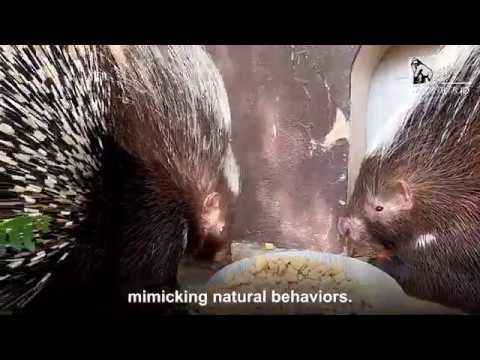- Detailed description of the African crested porcupine’s physical characteristics, habitat, and diet.
- Insights into the behavior and social structure of the African crested porcupine.
- Conservation status and efforts supporting the African crested porcupine population.
- The role of the African crested porcupine in the ecosystem and its interactions with other species.
- Management and care of African crested porcupines in captivity, considering their specific requirements and welfare.
The African crested porcupine is an intriguing mammal widely known for its unique adaptation and prominent quills. Its body, measuring up to 33 inches in length and weighing between 18 to 51 pounds, is a remarkable sight. The distinctive quills, reaching up to 12 inches long, are composed of keratin, the same protein found in human hair and nails. These robust quills are formidable defensive tools against predators, contributing significantly to the porcupine’s survival strategy. The quills lie flat against their bodies but can be erected when the porcupine feels threatened, creating an imposing display to deter potential threats.
The African crested porcupine inhabits diverse environments across sub-Saharan Africa, thriving in a range of habitats including forests, savannas, rocky hillsides, and even deserts. This adaptability underlines the species’ versatility in meeting its nutritional and shelter needs. Porcupines are primarily nocturnal, which enables them to forage efficiently under the cover of darkness. Their diet is predominantly herbivorous, consisting of roots, bulbs, fruits, and the bark of trees. They have a strong proclivity for calcium, often gnawing on bones to supplement their diet and maintain their quill strength.
Socially, the African crested porcupine is intriguing in its behaviors. It tends to live in familial groups known as coveys, usually consisting of a monogamous pair and their offspring. Within this structure, porcupines engage in various social behaviors, including mutual grooming and cooperative foraging. Contrary to their fierce exterior, these porcupines demonstrate a discernible social structure and reliance on their group for protection and social interaction.
Despite their hardy nature, African crested porcupines face several threats in the wild. Habitat destruction due to agricultural expansion and logging poses a significant threat. Moreover, they are sometimes hunted for their quills and meat, although not extensively targeted compared to other African wildlife. Conservation efforts primarily focus on habitat preservation and the enforcement of hunting regulations to maintain stable population numbers. Conservationists emphasize the importance of awareness and education to mitigate human-wildlife conflict and ensure sustainable coexistence.
Ecologically, the African crested porcupine plays a pivotal role in its environment. As part of their foraging behavior, porcupines inadvertently aid in seed dispersal, promoting plant biodiversity. Furthermore, their digging activities aerate the soil, enhancing nutrient cycling and soil health. These ecological roles underscore their integral connection to their habitat, contributing to ecosystem stability and diversity.
In zoological settings, the management and care of African crested porcupines require careful consideration of their natural behaviors and dietary needs. Enclosures must provide ample space for exploration and feature vegetation or structures that simulate their native habitats. Providing a diet rich in vegetables, fruits, and bones aids in maintaining their nutritional health and quill integrity. Enrichment activities such as foraging challenges stimulate their natural instincts and prevent boredom, promoting psychological well-being.
Handling African crested porcupines in captivity also requires expertise and caution due to their defensive quills. Zookeepers and wildlife handlers are trained to manage these animals with respect and diligence, safeguarding both the animal and themselves during interactions. These considerations ensure that captive porcupines lead enriching lives that mimic their wild counterparts’ experiences as closely as possible.
The African crested porcupine remains an integral subject of study within zoology and conservation circles. By understanding their role in the ecosystem, the threats they face, and effective management strategies in captivity, we enhance our capacity to protect this remarkable species. Our stewardship of the African crested porcupine underscores a broader commitment to conserving wildlife and biodiversity, ensuring that future generations can appreciate the richness of our world’s diverse animal life.
*****
Source Description
We’re staying sharp with our porcupine knowledge. Here are some facts about these prickly mammals.


